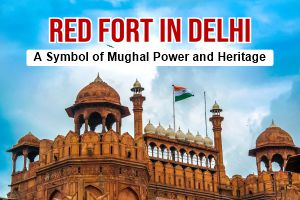If you are visiting Delhi, the capital city of India, you cannot afford to miss the Red Fort, one of the most iconic monuments of the country. The Red Fort, also known as Lal Qila (Hindustani), is a historic fort that served as the main residence and administrative center of the Mughal emperors for nearly 200 years. It is a masterpiece of Mughal architecture and a UNESCO World Heritage Site.

Red Fort
Tour Suggestion :-
8 Unique Experiences To Enjoy In The National Capital, Delhi
The Red Fort was built by Shah Jahan, the fifth Mughal emperor, who shifted his capital from Agra to Delhi in 1638. He commissioned the construction of a new city, Shahjahanabad, and a magnificent palace-fortress, the Red Fort, on the banks of the Yamuna River. The construction of the fort began in 1639 and was completed in 1648. It was named after its red sandstone walls that give it a distinctive appearance.
Tour Suggestion :-
Delhi Full Day Sightseeing Tour
The Red Fort covers an area of about 255 acres and is surrounded by a moat and a massive wall that has two main gates: the Delhi Gate and the Lahori Gate. The Lahori Gate is the main entrance to the fort and also the site where the prime minister of India hoists the national flag and delivers a speech on every Independence Day (15 August).
The Red Fort has many buildings and structures within its complex that showcase the splendor and elegance of Mughal art and culture. Some of the notable attractions are:

Tour Suggestion :-
10 Popular Places To Visit Near Delhi
Top Trending Destinations in India by Trip Advisor 2022
Also Read:- How to Reach and Things to do in Delhi
- The Diwan-i-Aam (Hall of Public Audience), where the emperor used to hear petitions and complaints from his subjects.
- The Diwan-i-Khas (Hall of Private Audience), where the emperor used to receive dignitaries and foreign envoys. It also housed the famous Peacock Throne, which was later taken away by Nadir Shah, the Persian invader, in 1739.
- The Rang Mahal (Palace of Colors), where the emperor’s wives and concubines lived. It has a beautiful ceiling painted with gold and silver flowers and a marble pool fed by a fountain.
- The Moti Masjid (Pearl Mosque), a private mosque built by Aurangzeb, the sixth Mughal emperor, for his personal use. It is made of white marble and has three domes and two minarets.
- The Mumtaz Mahal (Jewel Palace), one of the six palaces built for the emperor’s wives along the Yamuna River. It now houses a museum that displays various artifacts related to the Mughal era.
- The Khas Mahal (Private Palace), where the emperor used to sleep and relax. It has a marble screen that separates it from the Yamuna River and offers a scenic view of the Taj Mahal in Agra.
- The Hammam (Bath), where the emperor used to bathe and groom himself. It has three chambers with hot and cold water facilities and intricate decorations.
- The Hayat Bakhsh Bagh (Life-Bestowing Garden), a large garden with pavilions, fountains, pools and flower beds. It also has a tower called Zafar Mahal, which was added by Bahadur Shah Zafar, the last Mughal emperor.
You may be also interested in :-
The Red Fort in Delhi is not only a monument of historical significance but also a symbol of India’s pride and heritage. It is a place where you can witness the glory and grandeur of the Mughal empire and learn about its culture and traditions. It is also a place where you can experience the spirit of freedom and patriotism that inspired many freedom fighters during India’s struggle for independence.
